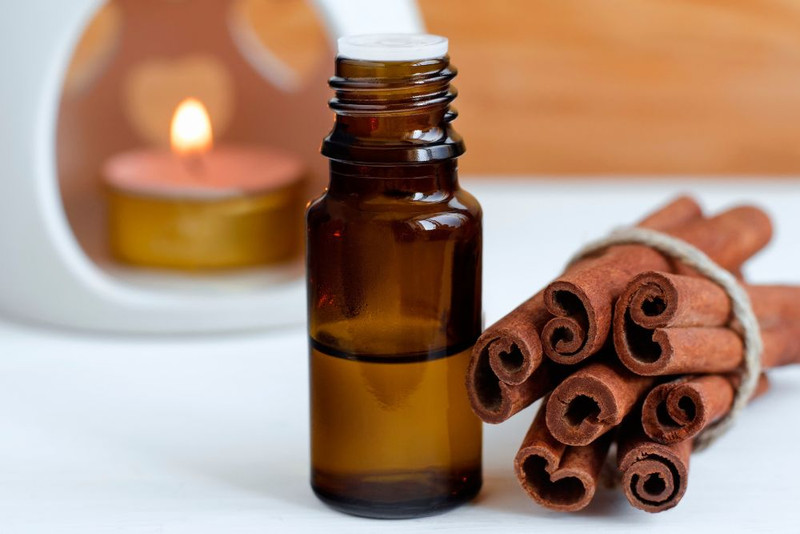Reviewed By: Kacie La
Contents:
Cinnamon is a plant that has a long history, dating back thousands of years. Its unique flavour and aroma have made it a popular spice in cuisines around the world, and cinnamon is prized for its versatile properties. At N-Essentials, we appreciate and celebrate these properties of plant and plant products, and harness them into your life.
An excellent product derived from the cinnamon plant is the cinnamon essential oil. Different parts of the cinnamon tree give us two different oils: cinnamon bark essential oil and cinnamon leaf essential oil. Both essential oils can be excellent additions to your home. To know how to use both essential oils, it is first important to understand their properties and differences. Read below to learn the differences between cinnamon bark essential oil and cinnamon leaf essential oil and how to use them.
Differences between cinnamon bark and cinnamon leaf essential oil
Both cinnamon bark and cinnamon leaf essential oil come from the same tree. The botanical name of the plant is Cinnamomum verum, which is the source of pure natural cinnamon essential oil. As their names suggest, cinnamon essential oils come from two different parts of the plant: the bark and the leaves. There are many differences between cinnamon bark and cinnamon leaf essential oils.
Manufacturing
During the harvesting process, cinnamon bark and leaf essential oils are manufactured in different ways.
After the cinnamon is gathered, the outer skin of the bark is removed to reveal the inner bark. When the inner bark is visible, thin layers of the bark are slowly peeled away. The layers are then curled after drying in the sun. Once curled, layers are folded repeatedly to form a cinnamon stick, which is then allowed to dry for an additional few days. The cinnamon bark essential oil is then created by steam distilling this bark.
To make cinnamon leaf essential oil, the process is a little simpler. Once the tree is harvested, the leaves are removed from the plant. The leaves go through a distillation process with steam or carbon dioxide to extract the essential oil.
Aroma
Cinnamon has a distinct woody aroma that can be found in both the leaf and bark oils. But there are slight differences here. Bark oil has the stronger cinnamon fragrance of the two. It is characterised as a herbaceous aroma, with hints of a spicy yet sweet scent. Cinnamon leaf essential oil, on the other hand, has a musky and warm fragrance that is much lighter. Compared to cinnamon leaf oil, the essential oil of cinnamon bark is hotter and more potent.
Thanks to their unique aromatic profiles, cinnamon leaf and cinnamon bark essential oils are two of the most popular oils used in home diffuser blends, perfumes and cosmetic products like soaps and shampoos.
Colour and consistency
There is a difference in the appearance of both oils too. Cinnamon bark oil has a rich golden-yellow colour and an oily consistency. The colour of cinnamon leaf oil varies from light brown to yellow, and has a thin-to-medium consistency.
Uses of cinnamon essential oil
Both types of cinnamon oil have a variety of cosmetic and household uses. While they cannot be combined or used together, they can offer individual benefits. Keep in mind that cinnamon bark essential oil is more potent than cinnamon leaf essential oil. The former needs to be diluted with a carrier oil and blends well with black pepper, clove or tea tree essential oil.
What is cinnamon bark essential oil used for?
Cinnamon bark essential oil is the perfect addition to many cosmetic products, including lotions and soaps because of its warm properties. When making your DIY soaps, use this oil with caution since it may darken the final product's colour. Cinnamon bark essential oil can also be applied on your hair. Regular application can give your hair a thicker appearance. Simply incorporate a drop of this natural oil into your regular shampoo and/or conditioner for a straightforward application.
Additionally, cinnamon bark oil is used in oil-based perfumes to add a hint of warm spicy fragrance. This oil's perfume is incredibly adaptable to different fragrance notes. It can enhance the richness of floral fragrances and works well with incense tones.
Lastly, this beneficial oil also possesses pest-repelling qualities. For a homemade natural insect repellent, simply mix 40 drops of cinnamon bark essential oil with 500ml of water to create a bug-killing spray. Because this oil is so potent, you don't need much. Shake it firmly each time before using.
What is cinnamon leaf essential oil used for?
Cinnamon leaf oil from N-essentials can be used in candles, lotions, soaps, and other all-natural skincare items. Typically, this oil will pair well with citrus or spicy essential oils.
The oil is the ideal addition to your diffuser because of its powerful aroma. Its fresh smell can completely change the atmosphere of a space. Add a few drops of cinnamon leaf essential oil to a diffuser filled with water to give your home a light, warm smell. You can add cinnamon leaf essential oil to homemade air fresheners and potpourri.
Apart from its aromatic benefits, this oil is added to cosmetic products like soaps and lotions since it can help reduce the appearance of dry skin. Cinnamon leaf oil can be combined with a carrier oil to make a massage oil. Create homemade massage oil by combining one drop of cinnamon leaf oil with two to three cups of carrier oil. Cinnamon leaf essential oil blends well with ginger, frankincense, lemon and lavender essential oils, among others.
Pure, natural cinnamon essential oil from N-Essentials
N-essentials is committed to giving everyone the chance to take advantage of the natural properties of cinnamon essential oil. With our experience, N-Essentials is able to source the highest quality natural essential oils from reputable trustworthy sources. Buy cinnamon essential oils from N-Essentials today! Get in touch with our team for more information about our range of essential oils.







